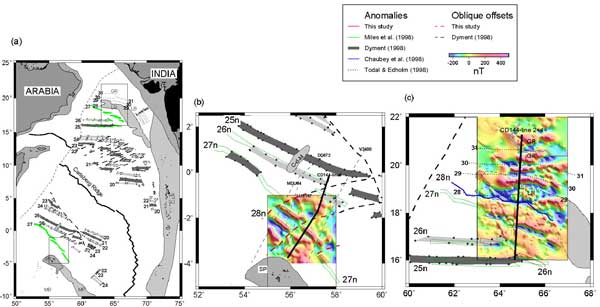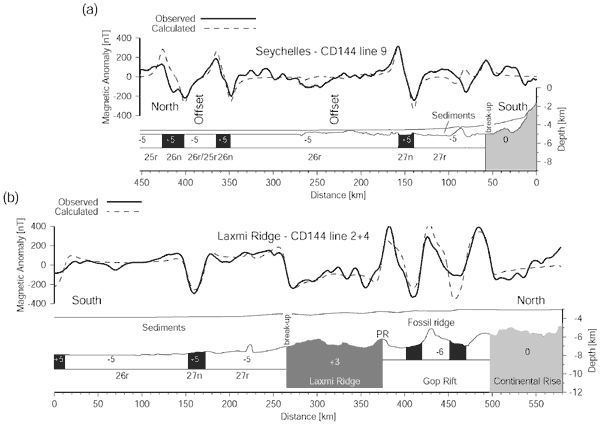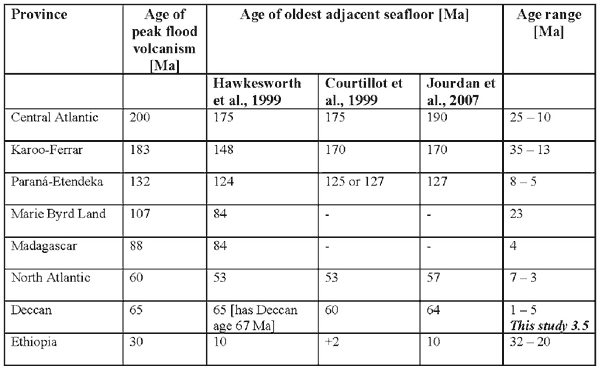 |
Age
of Seychelles-India break-up
|
J.S.
Colliera*,
V. Sansoma, O. Ishizukab,
R.N. Taylorc, T.A. Minshullc,
R.B. Whitmarshc
aDepartment
of Earth Science & Engineering,
Imperial College London, UK, jenny.collier@imperial.ac.uk; victoria.sansom@imperial.ac.uk
bInstitute of Geoscience, Geological
Survey of Japan/AIST, Japan, o-ishizuka@aist.go.jp
cSchool of Ocean and Earth Science,
University of Southampton, UK, rex@noc.soton.ac.uk; tmin@noc.soton.ac.uk; rbw@noc.soton.ac.uk
*corresponding author: Department
of Earth Science and Engineering, Imperial College
London, SW7 2AZ, UK email: jenny.collier@ic.ac.uk;
Tel: 44 20 7594 6443 Fax: 44 20 7594 7444
This webpage is a summary of the paper: Collier,
J.S., V. Sansom, O. Ishizuka, R.N. Taylor, T.A. Minshull
and R.B. Whitmarsh, Age of Seychelles–India
break-up, Earth Planet. Sci. Lett., 272,
264-277, 2008.
Introduction
Many continental flood basalt provinces are spatially
and temporally linked with continental break-up. Establishing
the relative timing of the two events is key to determining
their causal relationship. For example, models in which
the rifting results from uplift above the thermal anomaly
responsible for the flood basalts (active rifting, Richards
et al., 1989, Campbell & Griffiths,
1990) predict that flood basalt volcanism would significantly pre-date break-up.
According to Hill (1991), the time lapse between
flood basalt emplacement and break-up depends on the
initial thermal structure of the lithosphere, with
periods of 10-20 Ma expected for “normal” 200
km thick lithosphere. Alternatively, models in which
the extension is due to regional tectonics (passive
rifting, White & McKenzie, 1989) predict contemporaneous flood
basalt volcanism and break-up. Establishing which of
the models is correct has important implications for
plate-tectonics. In the active-rifting model, mantle
plumes play a strong, if not dominant, role in continental
break-up and thus changes in plate motions, whereas
in the passive-rifting model plate-boundary forces
are more significant.
Whilst our ability to determine the age of onshore
flood basalt provinces has improved greatly in recent
years it remains difficult to determine the age of
the associated rifting. The main reason for this is
that much of the rifting-associated volcanic products
lie offshore, where they are typically buried beneath
thick sedimentary piles that form as the continental
margins mature. Thus they are rarely sampled. Identifying
the first seafloor spreading magnetic anomaly adjacent
to rifted continental margins is commonly the only
way to place bounds on the age of continental break-up.
Whilst magnetic anomalies have proven a highly successful
way of determining seafloor age in mid-ocean settings,
their interpretation next to rifted margins is complicated
by other magnetic bodies within the ocean-continent
transition zone, such as syn-rift and early post-rift
volcanic rocks. Therefore because of the likelihood
of magmatic signatures unrelated to organized seafloor
spreading, it is only possible to accurately determine
the age of the first oceanic crust where additional
constraints, such as seismic data, exist. Experience
has also shown that it is advisable to study both sides
of a conjugate margin pair in tandem in order to resolve
better interpretational ambiguities and thus determine
more accurately when plate separation occurred.
In this webpage we discuss the relative age of the
Deccan Traps and the separation of India and the Seychelles.
Whilst there has been a growing consensus as to the
age of the main phase of the Deccan emplacement (65.5 ± 1
Ma, chron 29r, Courtillot & Renne, 2003),
the age of the rifting has remained unclear (Figure
1). Previous workers have identified the oldest seafloor
spreading magnetic anomaly between India and the Seychelles
to be either 27n (62.0 Ma; Schlich, 1982, Bhattacharya
et al., 1994, Miles et al., 1998), 28n
(64.1 Ma; Norton & Sclater, 1979, Naini & Talwani,
1982, Miles & Roest, 1993, Chaubey
et al., 1998), 29n (65.1 Ma; McKenzie & Sclater,
1971), or even 31n (68.7 Ma, Todal & Edholm,
1998, Shreider, 1998). Therefore there is
no agreement as to whether the break-up followed, was
contemporaneous with, or preceded flood basalt emplacement.
Much of the dispute has centred on the interpretation
of anomalies on the Indian side in an area known as
Laxmi Ridge/Gop Rift which modern plate reconstructions
show was conjugate to the Seychelles at the time of
break-up (Royer, 2002).

Figure 1 (a) Summary
of previous magnetic anomaly interpretations. The
boxes mark the conjugate study areas shown in b and
c. SP–Seychelles Plateau; MP–Mascarene
Plateau; M–Mascarene Basin; LR–Laxmi
Ridge; GR–Gop Rift; LB–Laxmi Basin; C-LR–Chagos-Laccadive
Ridge. (b) New magnetic anomaly grid (reduced
to the pole) and interpretation of the Seychelles
margin. Previous interpretations as indicated in
the key are shown for reference. The bold line labelled
CD144-line9 is the profile modelled in Figure 2.
(c) New magnetic anomaly grid (reduced to the pole)
and interpretation of the Laxmi Ridge margin. The
bold line labelled CD144-line2+4 is the profile modelled
in Figure 2. Click here or on Figure for enlargement.
We performed detailed seafloor magnetic
anomaly modeling of the north Seychelles and conjugate
Laxmi Ridge/Gop Rift margins in order to determine
the age of continental break-up. Unlike previous studies,
our models have external constraints on the crustal
structure obtained from co-incident wide-angle and
reflection seismic data (Minshull et al.,
2008; Collier et
al.,
2009).

Figure 2: Forward models of conjugate
magnetic anomaly profiles across the Seychelles and
Laxmi Ridge margins (see Figure 1 for line locations).
Oceanic crust is shaded black/white according to
polarity, continental crust light grey, and intermediate
crust dark grey. The natural remnant magnetization
strength in A/m is marked in each block and the susceptibility
is 0.04 (SI units) throughout. The “break-up” labels
mark the inception points of the Carlsberg Ridge.
PR–Palitana Ridge.
Data acquisition and analysis methods
We collected magnetic, swath bathymetry, seismic reflection
and seismic refraction data during two cruises onboard
RRS Charles Darwin–CD134b in November
2001 and CD144 in January/February 2003. In total,
900 km of data were collected at the Laxmi margin and
2800 km at the north Seychelles margin. The new magnetic
data were merged with historical measurements to produce
an anomaly grid for each study area (Figure 1).
Our conjugate magnetic profiles were interpreted using
2D forward modelling. The models consist of juxtaposed
uniformly magnetized blocks, the shapes of which included
basement topography from co-incident seismic reflection
data but were otherwise rectangular. Each block was
designated to be either oceanic, continental or intermediate
based on the seismic interpretation. Importantly, we
interpret the Gop Rift to be underlain by thick oceanic
crust and the Laxmi Ridge to be intermediate (probably
heavily intruded continental crust). The oceanic crust
was parameterized by a ~1.5 km thick upper crustal
layer with natural remnant magnetization of 5-6 A/m
and a susceptibility 0.04 SI. The continental crust
was assumed to have no natural remnant magnetization,
but a susceptibility of 0.04 SI. Intermediate crust
of the Laxmi Ridge was allowed to have a magnetized
layer of any thickness and strength.
Our work shows that syn-rift volcanics offshore the
Seychelles Islands in the form of seaward-dipping reflectors
were most likely erupted during chron 28n, and the
first organized seafloor spreading at the Carlsberg
Ridge also initiated during this period, at 63.4 Ma.
The severing of the Seychelles occurred by south-eastward
ridge propagation that was completed by the start of
chron 27n (~62 Ma). A brief, pre-Deccan phase of seafloor
spreading occurred in the Gop Rift, possibly during
32r (~73 Ma). A number of seamounts were also erupted
onto the seafloor during 27n-26n, 2-3 Ma after the
initiation of seafloor spreading. Initial extension
at the margin therefore preceded emplacement
of the Deccan traps, and separation of the Seychelles
was achieved within the next 3.5 Ma.
Comparison with other margins
Table 1 summarises recent compilations of the relative
ages of other continental-flood basalt-rifted continental
margin pairs (Hawkesworth et al., 1999, Courtillot
et al., 1999, Jourdan et al., 2007).
The compilations largely differ in the assignment of
the age of the first oceanic crust for the reasons
outlined in the introduction. Working with the currently
available constraints, the various margins fall into
two groups, those with short time lapses (< 10 Ma)–Paraná-Etendeka
(5-8 Ma), Madagascar (4 Ma), the North Atlantic Magmatic
Province (3-7 Ma), and those with relatively long time
lapses (> 10 Ma)–the Central Atlantic Magmatic
Province (25, or maybe 10 Ma), Karoo-Ferrar (13-35
Ma), Marie Byrd Land (23 Ma) and Ethiopia (20-32 Ma).
Our determination of 3.5 Ma for the Deccan and Seychelles-India
rift system confirms it to be the shortest time interval
so-far reported for any system worldwide.
Table 1. Summary of previous estimates of the
relative age of continental flood basalt provinces
and associated continental rifting.

Hill (1991) argued that in the active rifting
case, where the crustal extension was triggered by
thermal doming above an impacting plume, the establishment
of a new ridge would require tens of millions of years,
the time required for conduction of heat through the
upper lithosphere, unless a ridge jump was involved.
In the case of the Deccan, ridge jumping was clearly
involved, with spreading stopping in the Mascarene
basin between chrons 30 and 27 (Bernard & Munschy,
2000). Arguably a further factor that could have contributed
to the rapid break-up at the Seychelles-India margins
in the active plume case was that the lithosphere may
have been already thinned by the earlier rifting of
Greater India from Madagascar at 84 Ma and/or by the
interaction with earlier plumes–the Kerguelen
and Marion plumes (Kent et al., 1992). However,
our work shows that plate reorganisation was underway
long before the main Deccan eruption, with the opening
of the Gop Rift possibly preceding it by 9 Ma. We therefore
conclude that external plate boundary forces were largely
responsible for the rifting of the Seychelles from
India, and the evidence suggests that a passive, rather
than active, rifting model is more applicable in this
case.
References
-
Bernard, A. and M. Munschy (2000).
Were the Mascarene and Laxmi Basins (western Indian
Ocean) formed at the same spreading centre? Comptes
Rendus de l'Academie des Sciences - Series IIA,
Earth Planet. Sci. Lett., 330,
777-783.
-
Bhattacharya, G. C., A. K. Chaubey,
G. P. S. Murty, K. Srinivas, K. Sarma, V. Subrahmanyam
and K. S. Krishna (1994). Evidence for sea-floor
spreading in the Laxmi Basin, northeastern Arabian
Sea, Earth Planet.
Sci. Lett., 125, 211-220.
-
Campbell,
I. H. and R. W. Griffiths (1990). Implications
of Mantle Plume Structure for the Evolution of
Flood Basalts, Earth Planet. Sci. Lett., 99,
79-93.
-
Chaubey, A. K., G. C. Bhattacharya, G. P. S. Murty,
K. Srinivas, T. Ramprasad and D. G. Rao (1998). Early
Tertiary seafloor spreading magnetic anomalies and
paleo- propagators in the northern Arabian Sea, Earth
Planet. Sci. Lett., 154, 41-52.
-
Collier,
J.S., V. Sansom, O. Ishizuka, R.N. Taylor, T.A.
Minshull and R.B. Whitmarsh, Age of Seychelles–India
break-up, Earth Planet. Sci. Lett., 272,
264-277, 2008.
-
Collier, J. S., T. A. Minshull,
J. O. S. Hammond, R. B. Whitmarsh, J.-M. Kendall,
V. Sansom, C. I. Lane, and G. Rumpker (2009),
Factors influencing magmatism during continental
breakup: New insights from a wide-angle seismic
experiment across the conjugate Seychelles-Indian
margins, J. Geophys. Res., 114, B03101, doi:10.1029/2008JB005898.
-
Courtillot, V., C. Jaupart,
I. Manighetti, P. Tapponnier and J. Besse (1999).
On causal links between flood basalts and continental
breakup, Earth Planet.
Sci. Lett., 166, 177-195.
-
Courtillot,
V. E. and P. R. Renne (2003). On the ages of
flood basalt events, Comptes Rendus Geoscience, 335,
113-140.
-
Hawkesworth, C., S. Kelley,
S. Turner, A. Le Roex and B. Storey (1999). Mantle
processes during Gondwana break-up and dispersal. J.
Afr. Earth Sci., 28,
239-261.
-
Hill, R. I. (1991). Starting
Plumes and Continental Break-Up, Earth Planet.
Sci. Lett., 104,
398-416.
-
Jourdan, F., G. Feraud, H. Bertrand
and M. K. Watkeys (2007). From flood basalts to
the inception of oceanization: Example from the
Ar-40/Ar-39 high-resolution picture of the Karoo
large igneous province, Geochem. Geophys.
Geosys., 8, doi:10.1029/2008GC001994.
-
Kent, R. W.,
M. Storey and A. D. Saunders (1992). Large Igneous
Provinces - Sites of Plume Impact or Plume Incubation, Geology, 20,
891-894.
-
McKenzie, D. and J. G. Sclater (1971). Evolution
of the Indian Ocean, Geophys. J. Royal astron.
Soc., 25, 437-528.
-
Miles, P. R., M. Munschy and
J. Segoufin (1998). Structure and early evolution
of the Arabian Sea and East Somali Basin, Geophys.
J. Int., 134,
876-888.
-
Miles, P. R. and W. R. Roest
(1993). Earliest seafloor spreading magnetic anomalies
in the north Arabian Sea and the ocean-continent
transition, Geophys.
J. Int., 15, 1025-1031.
-
Minshull,
T. A., C. I. Lane, J. S. Collier and R. B. Whitmarsh
(2008). Rifting and Magmatism in the Northeastern
Arabian Sea, Nature Geoscience, 1,
463-467.
-
Naini, B. R. and M. Talwani
(1982). Structural framework and the evolutionary
history of the continental margin of western India.
Studies in continental margin geology. J. S. Watkins
and C. L. Drake. Tulsa, OK, Amer.
Assoc. Pet. Geol. AAPG Memoir, 34,
167-191.
-
Norton, I. O. and J. G. Sclater
(1979). A model for the evolution of the Indian
Ocean and the breakup of Gondwanaland, J. Geophys.
Res., 84,
6803-6830.
-
Richards, M. A., R. A. Duncan
and V. E. Courtillot (1989). Flood Basalts and
Hot-Spot Tracks - Plume Heads and Tails, Science, 246,
103-107.
-
Royer, J. Y., A.K. Chaubey,
J. Dyment, G.C. Bhattacharya, K. Shrinivas, V.
Yatheesh, T. Ramprasad (2002). Paleogene plate
tectonic evolution of the Arabian Sea and Eastern
Somali Basin, in P. D. Clift, D. Kroon, C. Gaedicke
and J. Craig (eds) The tectonic and climatic
evolution of the Arabian Sea region, Sp.
Pub. Geol. Soc. Lond., 195,
7-23.
-
Schlich, R. (1982). The Indian
Ocean: aseismic ridges, spreading centers and basins,
in A. E. M. Nairn and F. G. Stehli (eds) The Ocean Basins
and Margins,
New York, Plenum Press, 6, 51-147.
Shreider, A. A. (1998). The oldest paleomagnetic
anomalies in the Arabean Sea, Okeanologiya, 38,
911-918.
-
Todal, A. and O. Edholm (1998).
Continental margin off Western India and Deccan
Large Igneous Province, Mar.
Geophys. Res., 20, 273-291.
-
White,
R. S. and D. McKenzie (1989). Magmatism at rift
zones: the generation of volcanic continental
margins and flood basalts, J. Geophys. Res., 94,
7685-7729.
last updated 4th
March, 2009 |
